2020 Highlights
From universal profiles to universal scaling laws in X-ray galaxy clusters
- Details
- Published on 08 December 2020
Vol. 644
3. Cosmology
From universal profiles to universal scaling laws in X-ray galaxy clusters
The properties of galaxy clusters are shaped mainly by gravity and astrophysical dissipative processes and show remarkable universal behavior once they are rescaled by halo mass and redshift. In this work, the authors show that a universal pressure profile of the intracluster medium (ICM) combined with a halo–mass concentration–redshift relation and the hydrostatic equilibrium equations allow for the reconstruction of the radial profiles of the thermodynamical quantities. When they are integrated over a characteristic scale (such as the commonly used R500 radius), as was done in the observations, they produce the most important physical quantities for characterizing clusters, that is to say, the total mass, gas mass, temperature, and so on. These quantities in turn satisfy universal scaling laws. Using a large sample of clusters from the Planck observations, which have homogeneous X-ray data, the authors calibrate the predicted scaling laws. Their model not only reproduces the observed scaling laws well, but it also provides a way to interpret possible deviations from this self-similar behavior of galaxy clusters. For example, this comparison allows for the quantification of the effect of gas clumping on the studied sample.
MIRACLES: atmospheric characterization of directly imaged planets and substellar companions at 4-5 μm. II. Constraints on the mass and radius of the enshrouded planet PDS 70 b (Stolker et al.)
- Details
- Published on 26 November 2020
Vol. 643
10. Planets and planetary systems
MIRACLES: atmospheric characterization of directly imaged planets and substellar companions at 4-5 μm. II. Constraints on the mass and radius of the enshrouded planet PDS 70 b
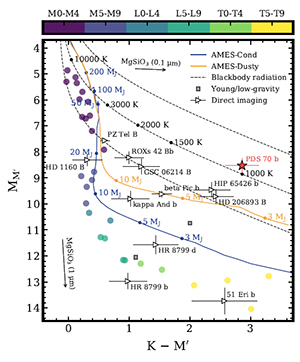
The young (~5 Myr) T Tauri star PDS 70 is an emblematic object for the study of planetary formation. It holds a gapped circumstellar disk in which two embedded planets (PDS 70 b and c) have been directly imaged and show evidence for gas accretion through detection of H alpha emission. The atmospheric and circumplanetary characteristics of these accreting young planets remain poorly understood, and a previous study of the spectral energy distribution of PDS 70 b has suggested a possible combination of emission from a planet atmosphere and a circumplanetary disk. Using VLT/NACO, Stolker et al. report the first detection of PDS 70 b in the Brα and M' filters as well as a tentative detection of PDS 70 c in Brα. PDS 70 b appears significantly redder than any previously imaged planets and brown dwarfs in the color (K-M') - magnitude (M') diagram. Fitting the resulting 1-5 um spectral energy distribution leads to a photospheric temperature Teff = 1193 +/- 20 K and a photospheric radius R = 3.0 +/- 0.2 R_J. In addition, by comparing the object's luminosity with predictions from planet structure models, and taking into account the accretion luminosity as constrained by H alpha, the authors were able to constrain the mass of PDS 70 b to Mp ≈ 0.5–1.5 M_J and its physical radius to Rp ≈ 1–2.5 R_J. The discrepancy between the photospheric and planetary radii may indicate that the planet is embedded in an extended dusty environment, muting molecular features in the object's spectrum, which implies that PDS 70 b not only accretes gas but is also continuously replenished by dust.
Common-envelope evolution with an asymptotic giant branch star (Sand et al.)
- Details
- Published on 24 November 2020
Vol. 643
7. Stellar structure and evolution
Common-envelope evolution with an asymptotic giant branch star
Common envelope evolution is an unresolved problem in binary evolution and a key for the formation of double compact objects. Hydrodynamic simulations show that the orbital energy released during spiral-in is not able to eject the complete envelope. The recombination energy of hydrogen and helium has long been proposed to play a crucial role during the ejection process. The authors carried out three-dimensional hydrodynamic simulations to study the common envelope evolution of a 1Msol early-AGB star with companions of different masses. They clearly demonstrate how recombination energy works to eject the complete envelope.
Detection of the Geminga pulsar with MAGIC hints at a power-law tail emission beyond 15 GeV
- Details
- Published on 20 November 2020
Vol. 643
1. Letters to the Editor
Detection of the Geminga pulsar with MAGIC hints at a power-law tail emission beyond 15 GeV
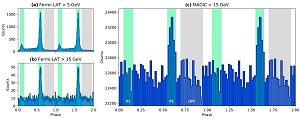
Geminga is the archetypal gamma-ray pulsar with no radio emission. Geminga has been observed up to 30 GeV by the Large Area Telescope (LAT) onboard the Fermi satellite. Previous attempts to detect Geminga by ground-based Cherenkov telescopes were unsuccessful. New observations carried out with the MAGIC telescope have succeeded in revealing a pulsed signal from Geminga up to 75 GeV. Modeling of the spectrum indicates that we are observing Geminga nearly perpendicularly to its rotation axis.
The spatially resolved broad line region of IRAS 09149-6206 (GRAVITY Collaboration)
- Details
- Published on 19 November 2020
Vol. 635
4. Extragalactic astronomy
The spatially resolved broad line region of IRAS 09149-6206

The GRAVITY collaboration reports on near-infrared interferometric spectra of the Br-gamma line, resolving the broad line region (BLR) of a nearby active galaxy nucleus (AGN). They are able to measure the size of the BLR (radius 0.075pc) and estimate the mass of the black hole (10^8 M_sun). These results are compatible with average values that have been measured in nearby AGNs through reverberation mapping as well as with the standard M_BH-sigma relation. A surprising result is the 0.14 pc offset between the BLR and the centroid of the hot dust distribution, which is traced by the 2.3 micron continuum. The hot dust is thought to be distributed in a ring, with a measured radius of 0.35 pc, since the high temperature inside the ring sublimates the dust. The offset falls well inside the ring and is thought to be due to the brightness asymmetry of the ring. A clear velocity gradient, almost perpendicular to the offset, is interpreted as the Keplerian rotation of the BLR.
Understanding and improving the timing of PSR J0737-3039B (Noutsos et al.)
- Details
- Published on 17 November 2020
Vol. 643
7. Stellar structure and evolution
Understanding and improving the timing of PSR J0737-3039B
The double pulsar (PSR J07373039A/B) is the only known system consisting of two radio pulsars in a 2.5hr orbit. Given its unique characteristics, and thanks to its incredible inclination of 89 degrees, it is our best laboratory for general relativity studies. Past studies have concentrated on pulsar A, a recycled millisecond pulsar spinning at 23 ms. Pulsar B is a normal pulsar spinning at 2.8 s. Being less powerful by a factor of ~3500, pulsar B is heavily embedded in the relativistic wind of pulsar A. In this paper, Noutsos and collaborators study pulsar B in detail, notably its emission during the time interval 2004-2008 when the pulsar was detectable before moving away from the line of sight due to geodetic precession. They have developed a model for the pulsar emission beam and its interaction with pulsar A's wind, and they make predictions for 2024 when pulsar B should become visible again. This will allow for more precise testing of the geodetic precession.
The solar gravitational redshift from HARPS-LFC Moon spectra. A test of the general theory of relativity (Gonzalez Hernandez et al.)
- Details
- Published on 17 November 2020
Vol. 643
13. Astronomical instrumentation
The solar gravitational redshift from HARPS-LFC Moon spectra. A test of the general theory of relativity

The general theory of relativity predicts that the wavelengths of solar spectrum lines should be shifted redwards compared to laboratory wavelengths by about 633 m/s in velocity scale. However, the competing blueshift due to granulation phenomena produced by convection makes an accurate observational test of this prediction extremely challenging. This paper presents the most accurate measurement of the solar gravitational redshift to date. The authors employed the laser frequency comb calibration system attached to the HARPS spectrograph on the ESO 3.6 m telescope at La Silla and observations of the sunlight reflected off the moon. State-of-the-art 3D hydrodynamical models of the solar atmosphere were then employed to analyze the spectral lines and measure an accurate gravitational redshift value, which is in full agreement with the theoretical prediction.
Tracing the total molecular gas in galaxies: [CII] and the CO-dark gas (Madden et al.)
- Details
- Published on 17 November 2020
Vol. 643
4. Extragalactic astronomy
Tracing the total molecular gas in galaxies: [CII] and the CO-dark gas
The CO molecule is the tracer of choice for inferring the amount of star-forming molecular hydrogen gas in our Galaxy and other galaxies with similar metallicities. In low-metallicity systems like dwarf galaxies, however, CO can fail to trace the full reservoir of H2 due to the presence of large quantities of molecular gas where CO has been photodissociated by penetrating far ultra-violet radiation. To account for this CO-dark gas, Suzanne Madden and collaborators have systematically studied the use of CII. Using grids of Cloudy models that span a variety of physical conditions and metallicities, these authors provide recipes for deriving total H2 mass estimates from CII observations. Using these models, they find that 70% to 100% of the total H2 mass in dwarf galaxies is not traced by CO(1-0) but is well traced by the λ 158 μm line of CII. When this CO-dark gas is accounted for, the dwarf galaxies are found to follow the same Schmidt-Kennicutt relation identified in more metal-rich disk galaxies.
A physical model for the magnetosphere of Uranus at solstice time (Pantellini)
- Details
- Published on 16 November 2020
Vol. 643
10. Planets and planetary systems
A physical model for the magnetosphere of Uranus at solstice time
The magnetosphere of Uranus is subject to strong seasonal variations. The variability is a consequence of the planet's rotation axis being nearly parallel to its orbital plane, a situation unique in the Solar System. A short rotation period of 17.24h and a large angle between the rotation axis and magnetic dipole axis induces a twist of the planetary magnetic field lines, which are forced to expand downstream of the planet under the action of the supersonic solar wind. Numerical simulations suggest the scale of the twist to be of the order of several hundred times the Uranian radius. Specifically, for the solstice case, simulations show that the planetary field lines expanding downstream of the planet become organized into two distinct interlaced helically structured bundles. This paper presents a detailed physical description of this tail structure for a Uranus-like magnetosphere at solstice, when the solar wind and the rotation axis are quasi-aligned. In a symmetrized version of the original problem, the paper describes the time evolution of a field line from its emergence through the planet's surface to its final position. It shows, for example, that in the planet frame, the asymptotic position is a unique one-dimensional static double helix, independently of the field line's emergence point. It also shows that each strand of a field line approaches its asymptotic position along a spiraling path, similarly to the path followed by a fluid parcel in a tornado.
Dust and gas in the central region of NGC 1316 (Fornax A). Its origin and nature (T. Richtler)
- Details
- Published on 11 November 2020
Vol. 643
4. Extragalactic astronomy
Dust and gas in the central region of NGC 1316 (Fornax A). Its origin and nature
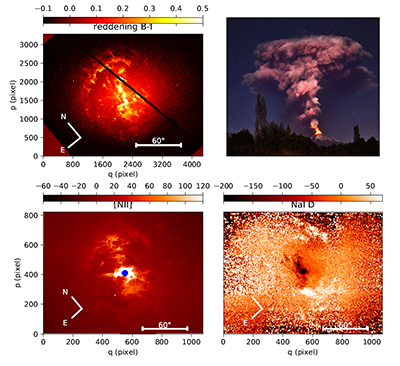
The central galaxy of the Fornax cluster, NGC 1316, is an early-type galaxy that hosts the radio source FornaxA. NGC 1316 reveals a perturbed dust structure within a 5kpc radius as well as gas that is probably accreted from a merger. Using archival HST/ACS color data and MUSE maps of the ionized gas, the authors studied the central stellar population as well as neutral (NaI D-lines) and ionized ([NII]) velocity fields. The excitation of the ionized gas is thought to come from the post-AGB stars of the old- and intermediate-age stellar population. In the dust-free regions, the interstellar NaI D lines appear in emission, which is indicative of a galactic wind. In the very center, a bipolar velocity field of the ionized gas is observed, which is interpreted as an outflow. There is also an almost edge-on gas and/or dust disk along the major axis of NGC 1316. The dust in NGC 1316 appears to have different origins. There exists an outflow that is curved along the line-of-sight. Nuclear outflows may be important dust-producing machines in galaxies. The dusty gaseous disk looks to be a predecessor for a central dust lane.
Parsec-scale properties of the radio brightest jetted AGN at z >6 (Spingola et al.)
- Details
- Published on 11 November 2020
Vol. 643
1. Letters
Parsec-scale properties of the radio brightest jetted AGN at z >6
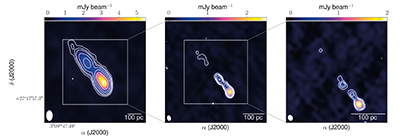
Blazars are powerful quasars with accretion disks that are nearly face-on. Additionally, their light beams and radio jets are approximately located along the line of sight and thus experience Doppler boosting. They tend to be under-abundant at high redshift with respect to the local universe. The authors report on the very long baseline interferometry of the most powerful jetted active galactic nuclei at z>6. Using milliarcsecond resolution, they discovered a bright one-sided jet about 500 pc long in projection that is resolved into multiple clumps. They derived its viewing angle as well as its Lorentz and Doppler factors. Surprisingly, its bulk Lorentz factor appears to be relatively low (less than 5), which might explain the paucity of high-z blazars with respect to current predictions. However, other scenarios have not been ruled out. More stringent constraints on this jet and other high-z blazars will be needed to form conclusions regarding the possible z-evolution of the blazar population.
A stringent upper limit of the PH3 abundance at the cloud top of Venus
- Details
- Published on 27 October 2020
Vol. 643
1. Letters to the Editor
A stringent upper limit of the PH3 abundance at the cloud top of Venus
A recent candidate detection of the phosphine molecule (PH3) with JCMT and ALMA in the upper atmosphere of Venus has incited a great deal of public interest. Phosphine is not expected to survive long in the highly oxidizing atmosphere of Venus, and its tentative detection has therefore been speculated to reflect biological processes in the Venusian atmosphere. Encrenaz et al. use observations of a 10 micrometer transition of phosphine to set an upper limit on its abundance at and slightly above the top of the Venus clouds. That limit is, at the 3 sigma confidence level, a factor of four lower than the PH3 abundance derived from the tentative millimeter-wave detection. The millimeter-wave transition of PH3 probes higher levels of the Venus atmosphere than the 10 micrometer transition, leaving the two results formally compatible; however, the tight upper limit obtained by Encrenaz et al. sets very strong constraints on phosphine production in Venus.Modeling protoplanetary disk SEDs with artificial neural networks. Revisiting the viscous disk model and updated disk masses
- Details
- Published on 16 October 2020
Vol. 642
6. Interstellar and circumstellar matter
Modeling protoplanetary disk SEDs with artificial neural networks. Revisiting the viscous disk model and updated disk masses
There are still several open questions in our understanding of planet formation, including the main mechanism responsible for angular momentum transport in protoplanetary disks or their apparent low masses compared to those of exoplanetary systems. Investigating these types of issues requires disk models that account for many physical processes, which also makes them computationally demanding. As a result, modeling large samples of disks can usually only be achieved with simpler models. In this work, Ribas et al. combine physically motivated viscous disk models with artificial neural networks to drastically speed up their computation times, which allows for modeling of spectral energy distributions of protoplanetary disks with detailed models using a Bayesian framework. Applying this approach to 23 protoplanetary disks in the Taurus-Auriga star-forming regions yields high viscosity values for many of them, which is in contradiction with recent ALMA results. This suggests that mechanisms other than viscosity could play a significant role in the transport of angular momentum in disks. The disk masses derived using full radiative transfer models are also systematically higher than those derived from (sub)mm fluxes alone, which could help alleviate the observed discrepancy between the masses of disks and exoplanetary systems.
A global model of particle acceleration at pulsar wind termination shocks
- Details
- Published on 13 October 2020
Vol. 642
2. Astrophysical processes
A global model of particle acceleration at pulsar wind termination shocks
Pulsar wind nebulae are among the brightest Galactic nonthermal sources at high energies, up through TeV, testifying to the efficient acceleration of charged particles in the vicinity of the central neutron star. Determining how to reach the required energies has been a challenging problem for decades. This study uses a schematic but physically plausible representation of the latitude-dependent pulsar wind and magnetic field into which leptons (electron-positron) are injected. The time dependent flow forms a shock, whose structure rapidly becomes macroscopically turbulent. The simulation uses a fully relativistic particle-in-cell (PIC) code, Zeltron, to follow the diffusive particle energization through this tangle of filamented structures at the termination shock of the wind with its surrounding interstellar medium (ISM). The formation of the shock over time is a result of the simulation and it is not pre-imposed, hence the complex structure development can be followed. This is perhaps the most intriguing result of the modeling, that is to say the synchrotron emission in different energy ranges is diagnostic for the site of origin: The highest energy emission comes from the turbulent regions imbedded within shock cavities and it is boosted and beamed by the local bulk motions at the shock.
ROSINA ion zoo at Comet 67P
- Details
- Published on 29 September 2020
Vol. 641
10. Planets and planetary systems
ROSINA ion zoo at Comet 67P

Popularized as the "cometary Zoo,” the richness of cometary neutral composition has been revealed at comet 67P Churyumov-Gerasimenko by the ROSINA instrument on board ESA's Rosetta mission. The ionization of neutrals by extreme ultraviolet radiation and energetic electrons produces cometary ions, whose subsequent reactions and collisions with neutrals may further enrich ion composition. Cometary atmosphere ionosphere models have thus predicted a whole suite of cometary cations, but remote sensing detections have been relatively scarce, and earlier in situ mass spectrometry on Giotto had insufficient mass resolution to distinguish between ion species of a similar mass. The situation has dramatically changed with the operation of ROSINA at comet 67P with a mass resolution of up to 3000, permitting, for example, one to distinguish 13C+ from CH+. Here, Beth et al. report on the detailed composition of the ionosphere of comet 67P, establishing the presence of many predicted catio! ns such a s CH_m+ (m = 1-4), H_nO (n=1-3), O+, Na+, and several ionized and protonated molecules (e.g., C2H4+, C2H5+, and CH3OH2+). A particular highlight is the discovery of CO2++, which was produced by the direct ionization of CO2, which represents the first detection of a molecular dication in any gas envelope in the Solar System.
The path to instability in compact multi-planetary systems
- Details
- Published on 28 September 2020
Vol. 641
10. Planets and planetary systems
The path to instability in compact multi-planetary systems

Three or more compact planetary systems can become unstable on timescales of up to billions of years. Predicting their stability is challenging and numerically expensive due to the chaotic dynamics, and, until now, there has been no theoretical understanding of the nature of the mechanism driving the instability. Based on numerical simulations, it had been postulated that the system's survival time follows an exponential trend in the planet orbital separation measured in units of Hill radii. Contrary to a constant diffusion process, planetary systems seem to remain dynamically quiescent for most of their lifetimes prior to a very short unstable phase. In this work, Petit and colleagues study a two-phase mechanism in which the slow chaotic diffusion due to the overlap of three-body resonances dominates the instability timescale prior to a rapid scattering phase triggered by the crossing of a two-planet mean motion resonance. They obtain an analytical estimate of the survival time that is consistent with numerical simulations over four orders of magnitude for the planet-to-star mass ratio, and six to eight orders of magnitude for the instability time. They also confirm that measuring the orbital spacing in terms of Hill radii is not suitable and that the correct spacing unit scales have a flatter dependency in the planet mass. Their model reproduces the observation that the survival time increases beyond a certain spacing since the three-planet resonances do not overlap.
Observed binary populations reflect the Galactic history
- Details
- Published on 25 September 2020
Vol. 641
10. Planets and planetary systems
Observed binary populations reflect the Galactic history
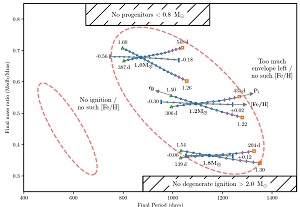
The authors demonstrate, for the first time, that the observed orbital period-mass ratio correlation of subdwarf B (sdB) binaries is caused by the metallicity history of our Galaxy. Metal-rich low-mass stars have larger radii at the tip of the first giant branch (FGB) than metal-poor low-mass stars. Consequently, the stable mass transfer of a metal-rich low-mass donor star ascending to the tip of the FGB leads to the formation of sdB binaries with longer orbital periods. The narrow sdB mass range, the narrow mass ratio range in the original binaries which lead to sdBs, and the Galaxy chemical evolution model, therefore, create the observed strong P-q correlation. We may see similar metallicity effects for other binaries which resulted from stable mass transfer of low-mass red giant donors, and we may expect that the accurately measured properties of the low-mass exotic binaries will provide new constraints on chemical evolution studies of the Galaxy.
The First Billion Years project: Finding infant globular clusters at z=6 ( Phipps et al.)
- Details
- Published on 22 September 2020
Vol. 641
5. Galactic structure, stellar clusters and populations
The First Billion Years project: Finding infant globular clusters at z=6
Globular clusters (GCs) are among the oldest gravitationally bound stellar systems as they are characterized by stellar populations with ages of 11.5 to 12.5 Gyr. They probably formed during, or just after, the epoch of reionization; therefore, the study of these systems at high redshift cannot only give insight into the processes and environments that governed star formation at that time, but they can also represent valuable probes of the reionization epoch itself. In this work, the authors conduct an analysis of the demographics and global properties of low-mass stellar systems at high redshift, within the numerical framework of the FiBY cosmological simulations. They identify a population of dense objects with M*<10^4 Msolar, such that the fraction of baryons (over the total mass of baryons and dark matter) is close to unity; they suggest that these objects are possible infant GC candidates. Compared to present-day GCs in the local Universe, these infant GCs have a higher gas fraction and consistently appear to be more extended with the properties of the few examples of proto-globulars currently observed at high-redshift. Forthcoming studies will examine the origin and future evolution of these systems to further progress our understanding of the role of low-mass stellar systems in early galaxy formation.Signatures of ubiquitous magnetic reconnection in the lower solar atmosphere (Joshi et al.)
- Details
- Published on 04 September 2020
Vol. 641
9. The Sun and the Heliosphere
Signatures of ubiquitous magnetic reconnection in the lower solar atmosphere
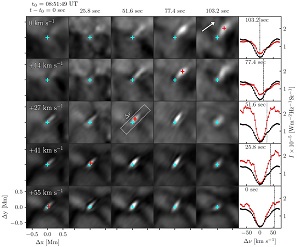 Magnetic reconnection is a fundamental physical process that governs a variety of high energy dynamics in the solar atmosphere, such as flares and coronal mass ejections. In the lower solar atmosphere, small-scale magnetic reconnection manifests as intense and compact brightenings in the wings of the hydrogen Balmer-a line; these manifestations are known as Ellerman bombs. Ellerman bombs are constituents of magnetically active solar regions and magnetic flux-emerging regions. Very recently, a phenomenon analogous to Ellerman bombs was discovered in regions of minimal magnetic activity on the solar surface, the quiet Sun, and termed as quiet Sun Ellerman bombs. Quiet Sun Ellerman bombs are the smallest observable magnetic reconnection phenomenon in the lower solar atmosphere. In this Letter, the authors, using high spatial resolution observations in the hydrogen Balmer-b line from the Swedish 1-m Solar Telescope, report that quiet Sun Ellerman bombs are ubiquitous and nearly uniformly distributed throughout the solar surface; there could be about half a million quiet Sun Ellerman bombs on the solar surface at any given time. The presented observations indicate that the magnetic reconnection leading to quiet Sun Ellerman bombs takes place in vertically extended current-sheets in intergranular lanes extending between the photosphere and chromosphere. It will be of great interest to study the role of this ubiquitous small-scale magnetic reconnection phenomenon in chromospheric and coronal heating.
Magnetic reconnection is a fundamental physical process that governs a variety of high energy dynamics in the solar atmosphere, such as flares and coronal mass ejections. In the lower solar atmosphere, small-scale magnetic reconnection manifests as intense and compact brightenings in the wings of the hydrogen Balmer-a line; these manifestations are known as Ellerman bombs. Ellerman bombs are constituents of magnetically active solar regions and magnetic flux-emerging regions. Very recently, a phenomenon analogous to Ellerman bombs was discovered in regions of minimal magnetic activity on the solar surface, the quiet Sun, and termed as quiet Sun Ellerman bombs. Quiet Sun Ellerman bombs are the smallest observable magnetic reconnection phenomenon in the lower solar atmosphere. In this Letter, the authors, using high spatial resolution observations in the hydrogen Balmer-b line from the Swedish 1-m Solar Telescope, report that quiet Sun Ellerman bombs are ubiquitous and nearly uniformly distributed throughout the solar surface; there could be about half a million quiet Sun Ellerman bombs on the solar surface at any given time. The presented observations indicate that the magnetic reconnection leading to quiet Sun Ellerman bombs takes place in vertically extended current-sheets in intergranular lanes extending between the photosphere and chromosphere. It will be of great interest to study the role of this ubiquitous small-scale magnetic reconnection phenomenon in chromospheric and coronal heating.
Fully compressible simulations of waves and core convection in main-sequence stars (Horst et al.)
- Details
- Published on 01 September 2020
Vol. 641
2. Astrophysical processes
Fully compressible simulations of waves and core convection in main-sequence stars
Turbulent core convection provides one mechanism to excite stellar oscillations (e.g. internal gravity waves) that amplify and disperse in the interior as they propagate. The corresponding surface wave spectra and signatures are still being debated within current investigations using multidimensional hydrodynamical simulations. While many approaches use a modified version of the equations of hydrodynamics as a basis for modeling, the method presented in the paper also accounts for compressibility effects and is thus able to recover acoustic waves in addition to internal gravity waves.
First detection of 13CH in the interstellar medium (Jacob et al.)
- Details
- Published on 26 August 2020
Vol. 640
6. Interstellar and circumstellar matter
First detection of 13CH in the interstellar medium
 The CH radical has long been recognized as a reliable proxy of molecular hydrogen in diffuse and translucent clouds. Its rare isotopolog $^{13}$CH, however, had been alluded to as a detection in the interstellar medium. In this paper, Jacob et.al present the detection of $^{13}$CH in absorption toward Sgr B2(M) and other galactic star-forming regions using the upGREAT receiver on board SOFIA. Combining these new data with previous observations of the main CH isotopolog toward the same sight lines, the authors have determined an improved estimate for the 12C^13 ratio as a function of the galactocentric distance.
The CH radical has long been recognized as a reliable proxy of molecular hydrogen in diffuse and translucent clouds. Its rare isotopolog $^{13}$CH, however, had been alluded to as a detection in the interstellar medium. In this paper, Jacob et.al present the detection of $^{13}$CH in absorption toward Sgr B2(M) and other galactic star-forming regions using the upGREAT receiver on board SOFIA. Combining these new data with previous observations of the main CH isotopolog toward the same sight lines, the authors have determined an improved estimate for the 12C^13 ratio as a function of the galactocentric distance.
Masses for the seven planets in K2-32 and K2-233. Four diverse planets in resonant chain and the first young rocky worlds
- Details
- Published on 11 August 2020
Vol. 640
10. Planets and planetary systems
Masses for the seven planets in K2-32 and K2-233. Four diverse planets in resonant chain and the first young rocky worlds
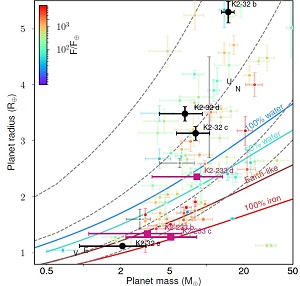 K2-32 and K2-233 are two planetary systems which host four and three planets, respectively. They were detected by the K2 mission transiting their host star. In this study, the authors measured their masses and bulk densities for the first time by using a long-term radial velocity follow-up with the HARPS instrument. K2-32 displays a similar architecture as our Solar System but in a scaled-down version, with a small rocky world in the inner regions, followed by a transitional sub-Saturn planet and two mini-Neptunes in the external region. All of them are in a compact resonant configuration inside half of Mercury’s orbit, which makes them key targets for atmospheric studies. With regard to K2-233, it is a young 600 Myr old star. Lillo-Box et al. confirmed in this study the rocky nature of the two inner planets in the system, thus representing the first instances of rocky worlds with measured masses around a young star. The two planets K2-233 b and c show masses and radii corresponding to a telluric composition. The results of this study allow for further investigations on the atmosphere of lower-mass planets, the early evolution of multi-planetary systems with rocky worlds, and the planet-planet interactions in compact multi-planetary systems in near resonant chains. The transiting nature of all of these planets and the precise bulk densities established in this work put them at the forefront of future atmospheric studies.
K2-32 and K2-233 are two planetary systems which host four and three planets, respectively. They were detected by the K2 mission transiting their host star. In this study, the authors measured their masses and bulk densities for the first time by using a long-term radial velocity follow-up with the HARPS instrument. K2-32 displays a similar architecture as our Solar System but in a scaled-down version, with a small rocky world in the inner regions, followed by a transitional sub-Saturn planet and two mini-Neptunes in the external region. All of them are in a compact resonant configuration inside half of Mercury’s orbit, which makes them key targets for atmospheric studies. With regard to K2-233, it is a young 600 Myr old star. Lillo-Box et al. confirmed in this study the rocky nature of the two inner planets in the system, thus representing the first instances of rocky worlds with measured masses around a young star. The two planets K2-233 b and c show masses and radii corresponding to a telluric composition. The results of this study allow for further investigations on the atmosphere of lower-mass planets, the early evolution of multi-planetary systems with rocky worlds, and the planet-planet interactions in compact multi-planetary systems in near resonant chains. The transiting nature of all of these planets and the precise bulk densities established in this work put them at the forefront of future atmospheric studies.
Near-infrared emission lines trace the state-independent accretion disc wind of the black hole transient MAXI J1820+070 (Sánchez-Sierras et al.)
- Details
- Published on 28 July 2020
Vol. 640
1. Letters
Near-infrared emission lines trace the state-independent accretion disc wind of the black hole transient MAXI J1820+070
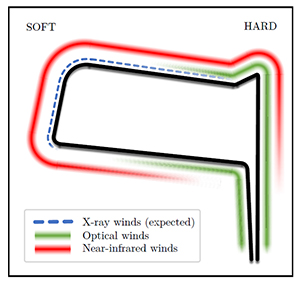
Blue-shifted absorption lines in the X-ray spectra of low mass X-ray binaries (LMXBs) provide the signature of hot winds from their accretion disk, carrying a sizable amount of material away. Cold winds also exist and are observed with the same characteristics in the optical spectra. Hot winds are preferentially observed during the "soft" state of LMXBs, when a disk is present and extends close to the compact object, dominating the X-ray spectrum. Cold winds are instead observed during the "hard" state when the standard accretion disk is pushed further out. Cold winds are revealed by blue-shifted lines in the optical spectra, mainly Hydrogen Balmer lines and He I (5976A). Here, Sánchez-Sierras and T. Muñoz-Darias monitored the evolution of the outburst from the black hole transient MAXI J1820+070 of which seven observations were taken with the X-shooter instrument at the ESO-VLT. These observations encompass the hard-soft-hard outburst evolution. Blue-shifted optical lines were previously observed in the "hard" state of MAXI J1820+070. The near-infrared (NIR) arm of X-shooter turned out to be particularly important on this topic: Blue-shifted Hydrogen Pashen and Brackett lines were observed during soft and hard states. The line shift is similar to what has been observed for optical lines. This result shows that NIR lines can be used to trace the cold wind across the entire LMXB outburst evolution and that cold winds are also present in the "soft" state.
Broad-line type Ic SN 2020bvc. Signatures of an off-axis gamma-ray burst afterglow (Izzo et al.)
- Details
- Published on 21 July 2020
Vol. 639
1. Letters
Broad-line type Ic SN 2020bvc. Signatures of an off-axis gamma-ray burst afterglow

Gamma-ray bursts (GRBs) are the brightest explosions in the Universe. There are two types of GRBs, and the long-duration ones are the outcome of the death of massive stars. A narrow, collimated jet pointing toward the Earth marks the GRB. At the same time, the star explodes giving rise to a supernova. GRBs that explode in the local Universe are almost always associated with broad-line, type Ic supernovae (i.e., those that were stripped more during the evolutionary path which brought them to explode). The supernova emission is isotropic and the GRB emission is collimated: We do expect that most of the type Ic supernovae lack a GRB, being that the Earth was missed by the jet. However, if we are just outside the GRB narrow jet, it is possible to observe an "orphan" GRB, that is to say a relativistic explosion without a high-energy signature. In this letter, Izzo et al. provide strong evidence for an off-axis GRB or choked jet (i.e., a jet which fails to break out from the star). This evidence comes from delayed X-ray emission - GRBs have a decaying X-ray afterglow and supernovae rarely have X-ray emission - and from the very high expansion velocity which is 20% of the speed of light, which were revealed from an early optical spectrum that was taken 1.5 d after the explosion. The off-axis viewing angle is ~25 degrees. The GRB barely missed the Earth and the authors were able to detect the X-ray emission thanks to its closeness of just 120 Mpc.
Gap, shadows, spirals, and streamers: SPHERE observations of binary-disk interactions in GG Tauri A (Keppler et al.)
- Details
- Published on 08 July 2020
Vol. 639
6. Interstellar and circumstellar matter
Gap, shadows, spirals, and streamers: SPHERE observations of binary-disk interactions in GG Tauri A

A large fraction of stars are found in multiple systems. More than 4000 detections of extrasolar planets around single stars raise the question as to if and how planets in binary systems may form. Since protoplanetary disks are the birthplaces of planets, thus dictating the initial conditions, their characterization is crucial to understanding the planet formation process. Unlike single star systems, numerical simulations predict that the gravitational impact of the central binary will severely perturb its surrounding disk, leading to the formation of a gap through which material in the form of streamers will feed the central stars. New high-resolution scattered-light observations of GG Tau A, one of the most massive and largest circumbinary protoplanetary disks, reveal binary-disk interactions in unprecedented detail. The disk shows evidence of a large gap, several shadowed regions, spiral structures, as well as streamer-like filaments connecting the outer disk and the central binary. These filaments are possibly generated by periodic perturbations from the binary, tearing off material from the inner edge of the outer disk once per orbit as predicted by numerical simulations.
Observational appearance of rapidly rotating neutron stars. X-ray bursts, cooling tail method, and radius determination (Suleimanov et al)
- Details
- Published on 03 July 2020
Vol. 639
7. Stellar structure and evolution
Observational appearance of rapidly rotating neutron stars. X-ray bursts, cooling tail method, and radius determination
There are several ongoing efforts to measure the neutron star equation of state. Various methods have been suggested to measure the neutron star mass and radius, including the cooling tail during "type I bursts", which occur when sufficient accreting matter deposits onto the neutron star surface, thus igniting the thermonuclear explosions. A specific spectral pattern is predicted due to the cooling neutron star surface, which can predict the neutron star radius with good accuracy. In this work, Suleimanov and colleagues compute the emission pattern for a rapidly rotating oblate (i.e., non-spherical) neutron star. This effect turns out to be important and overestimated by 3–3.5 km the neutron star radius (~30%).
Molecular globules in the Veil bubble of Orion IRAM 30 m 12CO, 13CO, and C18O (2–1) expanded maps of Orion A (Goicoechea et al.)
- Details
- Published on 01 July 2020
Vol. 639
6. Interstellar and circumstellar matter
Molecular globules in the Veil bubble of Orion IRAM 30 m 12CO, 13CO, and C18O (2–1) expanded maps of Orion A
Expanding bubbles in Orion A: [C II] observations of M 42, M 43, and NGC 1977
Strong winds and ultraviolet (UV) radiation from O-type stars disrupt and ionize their molecular core birthplaces, sweeping up material into parsec-sized shells. The "Veil bubble" in Orion represents a nearby example of such a shell, where the complexities of stellar feedback can be studied in detail. The Veil lies in front of the well-known M42 HII region, and it is driven by the Trapezium-cluster stars. In such a harsh environment dominated by shocks and UV radiation, little molecular emission is expected to be found. As Goicoechea et al. show, however, some pockets of molecular gas have managed to survive in the Veil, and they have been detected with the IRAM 30 m telescope as small CO globules. These globules have small masses and are moderately dense, and they seem to be confined by the shell's external pressure and are likely supported by magnetic fields. They are either transient objects that formed by hydrodynamic instabilities or pre-existing over-dense structures of the original molecular cloud. In a companion paper, Pabst et al. analyze [CII]158 microns observations of the Veil and other nearby bubbles in Orion, which were carried out with the upGREAT instrument on board SOFIA. The Veil bubble is found to have an expansion time of 0.2 Myr and to be driven by the mechanical energy input from the wind of the O-type star θ1 Ori C, the most massive star in the Trapezium. Whereas the nearby bubbles associated with M43 and NGC 1977 are caused by the thermal expansion of the gas ionized by their central later-type less massive stars.
Fermi Large Area Telescope observations of the fast-dimming Crab Nebula in 60–600 MeV (Yeung et al.)
- Details
- Published on 26 June 2020
Vol. 638
2. Astrophysical processes
Fermi Large Area Telescope observations of the fast-dimming Crab Nebula in 60–600 MeV
The supernova that exploded in 1054 gave rise to the following well-known nebula since the manufacturing of large telescopes: the Crab Nebula, which is the first object in the Messier’s list of nebulae. The Crab Nebula is also one of the brightest objects in the X-ray sky; it consists of a pulsar at its center and a powered wind nebula. The Crab is a very stable object in X-rays and it has been used by astronomers to calibrate instruments since the dawn of X-ray astronomy. At very high energies (60-600 MeV), the Crab is known to produce bright gamma-ray flares at a rate of ~1 per year. In this paper, Yeung and Horns report the discovery of fast dimming in the 60-600 MeV flux from the Crab, observed by the Fermi Large Area Telescope. Typically, the Crab weakens by a factor of ~5 in a timescale of a few days and remains faint for several weeks. This fast variability lends support to models which ascribe to the inner knot of the Crab Nebula (a spot at ~0.3 arcsec from the pulsar itself and visible in Hubble Space telescope images) from which very high energy emission is observed from the Crab, arising as synchrotron emission.
An in-depth reanalysis of the alleged type Ia supernova progenitor Henize 2-428 (Reindl et al.)
- Details
- Published on 24 June 2020
Vol. 638
7. Stellar structure and evolution
An in-depth reanalysis of the alleged type Ia supernova progenitor Henize 2-428
The planetary nebula Hen 2-428 was reported in 2015 to have a double degenerate core with an orbital period of 4.2 hours and, more excitingly, a combined mass of 1.76Msun, which is above the Chandrasekhar mass limit. The period and the mass imply that the system should merge in 700 million years and trigger in a type Ia supernova event. Reindl et al. most recently carried out an in-depth reanalysis of the alleged type Ia progenitor. They show that blends of He II λ 5412 Angstrom with DIBs resulted in an overestimation of the previously reported mass. The new total mass of the double degenerates is 1.08 Msun, a measurement that no longer exceeds the Chandrasekhar mass limit.
The GOGREEN Survey: A deep stellar mass function of cluster galaxies at 1.0
- Details
- Published on 23 June 2020
Vol. 638
4. Extragalatic astronomy
The GOGREEN Survey: A deep stellar mass function of cluster galaxies at 1.0 < z < 1.4 and the complex nature of satellite quenching
The origin of the bimodality of galaxies that separates star-forming from passive galaxies remains incompletely understood. In particular, it is not clear whether the mechanisms at play in the present-day Universe can also explain how star-formation quenched in distant galaxies. To address this question, van den Burg et al. realized the most precise measurement of the stellar mass function of galaxies in the dense environment of 11 galaxy clusters at z=1 to 1.4 using photometric measurements from the blue to the 4.5 microns bands. Surprisingly, what they find is in stark contrast to what several studies concluded from the study of nearby galaxies. These studies refer to the following two mechanisms that act separately and independently in the local Universe: a mass-independent environmental quenching and an environment-independent mass quenching. When they compare the stellar mass functions of star-forming and passive galaxies in the clusters and in the field at z=1-1.4, the authors find no signature of purely mass-independent environmental quenching. Instead galaxies in clusters appear to quench through the same processes as those in the field, simply they do so at an earlier time. They conclude that galaxies that are destined to become part of z=1-1.4 clusters start their formation “early” with respect to galaxies in the field, but they quench via a similar physical process.
Evidence for a rapid decrease of Pluto’s atmospheric pressure revealed by a stellar occultation in 2019 (Arimatsu et al.)
- Details
- Published on 15 June 2020
Vol. 638
1. Letters
Evidence for a rapid decrease of Pluto’s atmospheric pressure revealed by a stellar occultation in 2019
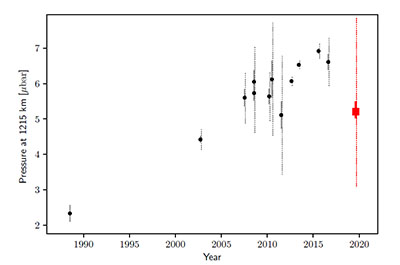
Pluto's atmosphere originates from sublimation-condensation equilibria of surface volatiles, primarily N2. Pluto's strongly elliptical orbit and high obliquity lead to marked seasonal variability of the local insolation. Regular monitoring of stellar occultations over the last 30 years has revealed that although Pluto has been receding from the Sun since 1989, its atmospheric pressure has increased by a factor of ~3 from 1988-2016. Based on climate models, this is best understood to be due to the evolution of insolation over Sputnik Planitia, the largest reservoir of N2 ice on Pluto, and models have predicted that the pressure should progressively decline after 2015, which is a consequence of the subsolar point moving to higher northern latitudes. Using a single-chord stellar occultation observed from Hawaii, Arimatsu et al. determine that Pluto's atmospheric pressure in 2019 was approximately 21% lower than it was in 2016. Although significant at 2.4 sigma only, this result! suggests that Pluto's long-expected atmospheric decline has started, and at a pace faster than anticipated by models, possibly pointing to additional regions of nitrogen ice deposition. Continuing the monitoring of Pluto's atmosphere is needed to confirm the trend and improve our understanding of Pluto's climate and its atmospheric sublimation-condensation cycles.
Revised mass-radius relationships for water-rich rocky planets more irradiated than the runaway greenhouse limit (Turbet et al.)
- Details
- Published on 09 June 2020
Vol. 638
10. Planets and planetary systems
Revised mass-radius relationships for water-rich rocky planets more irradiated than the runaway greenhouse limit
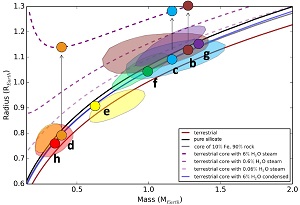
With seven rocky planets on temperate orbits, of which three are considered to be in the habitable zone, the TRAPPIST-1 system is one of the best characterized and fascinating planetary systems. Based on knowledge of their masses, radii, and densities, previous studies inferred that most of the seven planets are likely enriched in volatiles (e.g., water), up to tens of percent of the planetary masses. However, the three innermost planets (TRAPPIST-1b, c, and d) receive more irradiation from the star than the runaway greenhouse limit, implying that all of their putative water reservoir could actually form a steam atmosphere, and it has been shown in a recent study by Turbet et al. (2019) that this situation leads to strong atmospheric expansion. Here the authors apply these concepts to propose revised mass-radius relationships for this class of planets, providing, in particular, empirical formulas for the thickness of the H2O steam atmosphere as a function of planet core gravity and the radius, water content, and irradiation. For a given water-to-rock mass ratio, these new mass-radius relationships lead to planet bulk densities that are much lower than if water is assumed to be in its condensed form, implying that the latter assumption considerably overestimates the planets' bulk water endowment. The application to the TRAPPIST-1 system implies that when assuming a terrestrial core composition, TRAPPIST-1b, c, and d can accommodate a water mass fraction of 0.1-2 %, at most, and perhaps even much less.
Unexpected late-time temperature increase observed in the two neutron star crust-cooling sources XTE J1701-462 and EXO 0748-676 (Parikh et al.)
- Details
- Published on 08 June 2020
Vol. 638
1. Letters
Unexpected late-time temperature increase observed in the two neutron star crust-cooling sources XTE J1701-462 and EXO 0748-676
During an X-ray outburst, a transient neutron star accretes matter which then heats the crust. After the outburst has ended, the neutron star cools, providing invaluable insights into the properties of the crust. Without further sources of heat, the compact object is expected to continue to cool. This simple physical picture is challenged by the observations presented in this Letter, in which a late time rise in temperature has been observed in two transient systems years after the outburst ended. As the authors have stated, this rise in temperature is unexplained. Further studies should lead to a deeper understanding of the dense matter physics.
Mt. Wendelstein imaging of comet 41P/Tuttle-Giacobini-Kresak during the 2017 perihelion arc (H. Boehnhardt et al.)
- Details
- Published on 29 May 2020
Vol. 638
10. Planets and planetary systems
Mt. Wendelstein imaging of comet 41P/Tuttle-Giacobini-Kresak during the 2017 perihelion arc
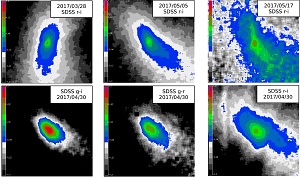
Comet 41P/Tuttle-Giacobini-Kresak (41P), a Jupiter family comet with three discoveries over about 100 years, is in a short-periodic orbit around the Sun with the perihelion close to the Earth distance. The 2017 apparition of 41P offered a long-lasting visibility of the comet at a close distance to Earth. The four month-long imaging campaign with the 2 m telescope at the Mount Wendelstein Observatory was aimed at characterizing dust activity and nucleus properties of the comet. Using a new analysis method of the inner coma flux, we derived a small mean equivalent radius of about 600 m for the nucleus with an unusual body axes ratio that is higher than two. The nucleus rotation axis was determined from the geometric appearance of coma structures, which were enhanced in the images. A long-lasting coma fan was produced by an extended region at high latitudes on the slowly rotating nucleus, whereas isolated jets originated from narrow, low latitude active regions on the nucleus. The dust activity of 41P, despite being difficult to quantify exactly because of an unknown phase function correction for the comet, indicates a steep radial profile that falls off with an increasing distance from the Sun. Colors and flux profiles provide evidence for dust fragmentation in the inner coma of the comet. A singular outburst event created various dust structures in the coma. The outburst came from an extended region on the nucleus and was due to either a landslide on the nucleus or a sudden material release from a subsurface pocket of volatile ice.
Liverpool-Maidanak monitoring of the Einstein Cross in 2006–2019. I. Light curves in the gVrRI optical bands and microlensing signatures (Goicoechea et al.)
- Details
- Published on 19 May 2020
Vol. 637
4. Extragalactic astronomy
Liverpool-Maidanak monitoring of the Einstein Cross in 2006–2019. I. Light curves in the gVrRI optical bands and microlensing signatures
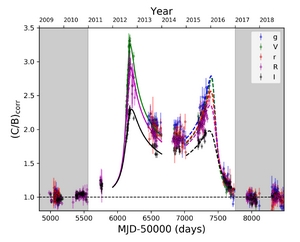 The Einstein Cross is a gravitationally lensed quasar at z= 1.695. The quasar QSO 2237+0305 is lensed in four images (A, B, C, and D) that are arranged like a cross around the nucleus of a nearly face-on spiral galaxy (the lens) at z =0.039. In addition to the global strong lensing, compact objects, such as stars, in the lensing galaxy produce microlensing and differential magnification of the four images. In order to gain more insight into these compact objects, the authors monitored the Einstein Cross using 4 374 optical frames (gVrRI) taken with the 2 m Liverpool and the 1.5 m Maidanak telescopes, over the 2006-2019 period, yielding light curves of the four images A-D. The differences between A-D light curves reveal strong microlensing signatures, affecting the C image, which experienced a double caustic crossing. The UV continuum of the quasar is modeled by a standard accretion disk of radius R, which increases with wavelength as a power law of exponent alpha=1.33. More monitoring data are required to draw a more robust conclusion.
The Einstein Cross is a gravitationally lensed quasar at z= 1.695. The quasar QSO 2237+0305 is lensed in four images (A, B, C, and D) that are arranged like a cross around the nucleus of a nearly face-on spiral galaxy (the lens) at z =0.039. In addition to the global strong lensing, compact objects, such as stars, in the lensing galaxy produce microlensing and differential magnification of the four images. In order to gain more insight into these compact objects, the authors monitored the Einstein Cross using 4 374 optical frames (gVrRI) taken with the 2 m Liverpool and the 1.5 m Maidanak telescopes, over the 2006-2019 period, yielding light curves of the four images A-D. The differences between A-D light curves reveal strong microlensing signatures, affecting the C image, which experienced a double caustic crossing. The UV continuum of the quasar is modeled by a standard accretion disk of radius R, which increases with wavelength as a power law of exponent alpha=1.33. More monitoring data are required to draw a more robust conclusion.
Tracing the anemic stellar halo of M101 (In Sung Jang et al.)
- Details
- Published on 28 April 2020
Vol. 637
4. Extragalactic astronomy
Tracing the anemic stellar halo of M101

Cosmological models of galaxy formation show that disk galaxies are embedded in extended stellar halos. However, previous studies of some disk galaxies have failed to detect this stellar component. This was the case of the prototypical disk galaxy M101, for which it has been suggested that it lacked this stellar halo component. In using optical imaging with the Hubble Space Telescope (HST), it is now possible to resolve M101 stars and map their halo out to 70 kpc from the center. The new color-magnitude diagrams reach down to two magnitudes fainter than the tip of the red giant branch (RBG). This allowed HST to trace the M101 halo component down to very faint surface brightness (μg ≈ 34 mag arcsec−1). The stellar population is found to be similar to that of metal-poor globular clusters in the Milky Way based on the mean color of the RGB stars. The HST star counts also allowed the authors to measure the total halo mass of M101, which is small in comparison to! Well studied galaxies, such as the Milky Way or M31. Indeed, the comparison with the other six galaxies from the same survey shows that M101 has an anemic stellar halo.
Deep Horizon: A machine learning network that recovers accreting black hole parameters (van der Gucht et al.)
- Details
- Published on 22 April 2020
Vol. 636
15. Numerical methods and codes
Deep Horizon: A machine learning network that recovers accreting black hole parameters
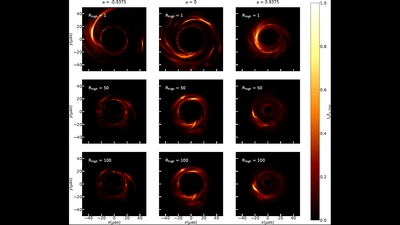
In April 2019, the Event Horizon Telescope released the first ever image of the shadow of a black hole at the center of the M87 elliptical galaxy, dominating the Virgo cluster. These observations were made possible by eight ground-based radio telescopes spread all over the world. In this paper, van der Gucht et al. present a combination of two neural network algorithms that are able to recover the physical parameters of the accreting black hole based on the observed shadow. To train these networks, they used a set of general relativistic simulations of accretion disks around massive black holes, testing a grid of parameters. They discover that with the current resolution, only the mass of the black hole and the mass accretion rate can be safely recovered. To derive further parameters, such as the black hole spin, we would need to go beyond the Earth-based set of radio telescopes and include a space-based radio mission.
Is there NaI in the atmosphere of HD 209458b? Effect of the centre-to-limb variation and Rossiter-McLaughlin effect in transmission spectroscopy studies (Casasayas-Barris et al.)
- Details
- Published on 03 April 2020
Vol. 635
10. Planets and planetary systems
Is there NaI in the atmosphere of HD 209458b? Effect of the centre-to-limb variation and Rossiter-McLaughlin effect in transmission spectroscopy studies

HD209458b has a special status among exoplanets. It was the first one shown to transit in front of its star and the first one for which an atmospheric signature (atomic sodium) was reported from spectroscopy in 2002, which was seemingly confirmed in subsequent observations. Transit spectroscopy in which spectra in- and off-transit are rationed to extract the transmission spectrum of the planet's atmosphere is simple in its principle, but it may be fraught with complex effects. Those include the nonuniform brightness of the star (center-to-limb variations, CLV) and the Rossiter-McLaughlin (RM) effect in which the planet progressively occults regions of the star with different line-of-sight velocities, causing a shift in the stellar lines as the transit proceeds. In focusing on the sodium D lines in HD209458, Casasayas-Barris present a detailed modeling of these effects and demonstrate that, even the lack of any absorption by the planet's atmosphere, can lead to apparent spectral features in transmission spectroscopy. Most remarkably, calculations indicate that those features may predominantly show up in emission. By comparing model predictions to archival data from HARPS-N and CARMENES, they conclude that transmission spectra actually reveal no detectable Na I atmospheric absorption due to the planet. The study also provides a natural explanation for the Na I emission features seen in earlier HST/STIS observations of the system, which had been previously interpreted to be due to telluric contamination. More broadly, this work indicates the need for careful reassessment of some of the atmospheric identifications based on exoplanet transit spectroscopy.
The origin of tail-like structures around protoplanetary disks (Vorobyov et al.)
- Details
- Published on 01 April 2020
Vol. 635
6. Interstellar and circumstellar matter
The origin of tail-like structures around protoplanetary disks

The origin of the enigmatic tail-like structures recently detected around the disks of several young stars was studied using numerical hydrodynamics simulations. Two possible formation mechanisms were considered: ejections of gaseous clumps from dynamically unstable protostellar disks and close encounters between quiescent protoplanetary disks and intruder stars. The authors demonstrate that ejected clumps produce a unique type of tail that is characterized by a bow-shock shape. Such tails originate from the supersonic motion of clumps ejected through the dense envelope that often surrounds young protostellar disks. On the other hand, close encounters between an intruder star and a protoplanetary disk produce three types of such tail-like structures. The authors define these as pre-collisional, post-collisional, and spiral tails. These tails can be distinguished from one another by particular features of the gas and dust flow in and around them. The estimated mass of gas and dust in the tail can amount to tens of Jovian and Earth masses, respectively, which is higher than what was inferred for similar structures in SU Aurigae and FU Orionis. The authors argue that tail-like structures around protostellar and protoplanetary disks can be used to infer interesting phenomena, such as clump ejection or close encounters. In particular, the bow-shock morphology of the tails could point to clump ejections as a possible formation mechanism.
Hidden magnetic fields of young suns (Kochukhov et al.)
- Details
- Published on 23 March 2020
Vol. 635
7. Stellar structure and evolution
Hidden magnetic fields of young suns
Spectropolarimetric observations analyzed with the Zeeman Doppler imaging (ZDI) technique routinely measure the large-scale magnetic fields of active solar-like stars. Due to the cancelation of opposite field polarities, polarimetry is however blind to any small-scale component of the field. Zeeman broadening in high-resolution intensity spectra, by contrast, probes the total magnetic field and can therefore reveal these hidden small-scale components. Kochukhov et al. developed a new magnetic field diagnostic method based on the relative Zeeman intensification of optical atomic lines with different magnetic sensitivity, which bypasses the traditional difficulty of disentangling the Zeeman effect from the other broadening mechanisms which affect spectral lines. By using this new technique and comparing the same stars with spectropolarimetry, they find that ZDI recovers about 1% of the total energy of the magnetic field in the most active solar-like stars and just 0.01% for their least active targets. Their results also suggest that magnetic regions have roughly the same local field strength in all solar-like stars, with the filling factor of such regions systematically increasing with stellar activity.Reionization optical depth determination from Planck HFI data with ten percent accuracy (Pagano et al.)
- Details
- Published on 16 March 2020
Vol. 635
3. Cosmology
Reionization optical depth determination from Planck HFI data with ten percent accuracy
While it is true that the reionization optical depth determination has been greatly improved over the last two decades, tau is still the less constrained parameter of the lambdaCDM model. Uncertainties and systematics produce discrepant results for different large-scale CMB datasets (primarily Planck and WMAPS) and various methods. In this paper, the authors present an advanced approach to the Planck High Frequency Instrument (HFI) data using an improved version of the HFI map-making code, greatly reducing the residual large-scale contamination affecting the data. With large-scale polarization-only data, they measured tau = 0.0566 +0.0053 -0.0062 at 68% C.L., reducing the Planck 2018 legacy release uncertainty by ~40%. Within the lambdaCDM model, applied in combination with the Planck large scale temperature likelihood and the high-temperature and polarization likelihood, they measured tau = 0.059ą0.006 at 68% C.L. which corresponds to a mid-point reionization redshift of z re = 8.14ą0.61. This estimation of the reionization optical depth with 10% accuracy is the strongest constraint obtained to date.Plasma-environment effects on K lines of astrophysical interest (Deprince et al.)
- Details
- Published on 09 March 2020
Vol. 635
12. Atomic, molecular, and nuclear data
Plasma-environment effects on K lines of astrophysical interest III. IPs, K thresholds, radiative rates, and Auger widths in Fe ix – Fe xvi
X-ray spectroscopy is the primary tool used to achieve an understanding of the inner zones of accretion flows in a wide variety of cosmic sources, particularly neutron stars and black holes. The resonance lines of highly ionized species of iron are among the most important spectral diagnostics available. This paper presents a novel, detailed study of the hitherto neglected ambient effects of plasma screeing and K transition wavelength shifts and thresholds, as well as the reduction in the ionizaton energies, on the interpretation of observations from the high-density environments expected in the inner portions of such flows.High-precision polarimetry of nearby stars (Piirola et al.)
- Details
- Published on 06 March 2020
Vol. 635
6. Interstellar and circumstellar matter
High-precision polarimetry of nearby stars (d<50 pc)
Understanding the magnetic field of the interstellar medium (ISM) in the vicinity of the Sun is a supremely challenging task, requiring ultra-high-precision polarimetric measurements of as large a sample of stars with known distances as possible. This benchmark study uses a sample of 361 bright F and G stars to obtain UBV photometric polarimetry to a remarkable level, 10^(-5). A subset of the sample of nonactive stars shows some marginal evidence of variability, which is probably intrinsic. A key result is the delineation of large angular-scale coherent filamentary structures, which are detected in the position angle maps that correspond to features known from the local ISM. In particular, there is a signature of the Interstellar Boundary EXplorer (IBEX) ribbon that is connected with the local IS magnetic field, which was modified by the heliosphere. The study also shows correlations between high-latitude large arc structures revealed by samples at distances from 100 to 500 pc and those closer than 50 pc.Hunting for open clusters in Gaia DR2: 582 new open clusters in the Galactic disc (Castro-Ginard et al.)
- Details
- Published on 04 March 2020
Vol. 635
5. Galactic structure, stellar clusters and population
Hunting for open clusters in Gaia DR2: 582 new open clusters in the Galactic disc
 Open clusters have served as vital laboratories for the development and testing of stellar evolution theory. These clusters have also been fundamental for the exploration of the disk in our own Milky Way. The Gaia mission has now enabled the discovery study of massive numbers of Galactic star clusters. As such, the present discovery of 582 new open clusters using machine learning techniques is a treasure. These objects are very tricky to detect due to the high level of contamination related to their being embedded in the Galactic disk. They have been found as clear overdensities in the spatial and proper-motion parameter space, which was confirmed using Gaia optical photometry. Interestingly, the new data also facilitated the discovery of the tidal tails from an intermediate-age open cluster that is in the process of being disrupted by the Galactic tidal field, illustrating the potential of combining Gaia data with these modern machine learning techniques. A great deal of progress is expected to be made on this front in the future as we all eagerly await Gaia DR3.
Open clusters have served as vital laboratories for the development and testing of stellar evolution theory. These clusters have also been fundamental for the exploration of the disk in our own Milky Way. The Gaia mission has now enabled the discovery study of massive numbers of Galactic star clusters. As such, the present discovery of 582 new open clusters using machine learning techniques is a treasure. These objects are very tricky to detect due to the high level of contamination related to their being embedded in the Galactic disk. They have been found as clear overdensities in the spatial and proper-motion parameter space, which was confirmed using Gaia optical photometry. Interestingly, the new data also facilitated the discovery of the tidal tails from an intermediate-age open cluster that is in the process of being disrupted by the Galactic tidal field, illustrating the potential of combining Gaia data with these modern machine learning techniques. A great deal of progress is expected to be made on this front in the future as we all eagerly await Gaia DR3.
Stripped stars during the reionization of hydrogen and helium (Götberg et al.)
- Details
- Published on 25 February 2020
Vol. 634
Sect. 3. Cosmology
Contribution from stars stripped in binaries to cosmic reionization of hydrogen and helium
The presence of massive binary stars has been known to boost the production of ionizing radiation in the stellar populations: as such, it is extremely important to assess their contribution in the global ionizing budget during the reionization transition. In this work, the authors investigate the contribution of stars stripped of their hydrogen-rich envelopes in binaries. Such envelope-stripping is predicted to be the most common type of interaction in binaries as it is the fate of a third of all massive stars. Because stars over a wide range of masses can become stripped, the resulting ionizing radiation is emitted over an extended period of time after a starburst, therefore, these systems can boost the ionizing emission of stellar populations at late times. The authors find that stars stripped in binaries are likely to have had important effects on cosmic reionization since they could have provided ∼ 20% of the photons that reionized hydrogen in the Universe. On the other hand, the He ii-ionizing emission from stripped stars is not sufficient to compete with AGN and significantly impact the complete reionization of helium, although they might have contributed to the initial part of this process. Finally, the harder resulting spectra from stellar populations lead to an increased temperature of the IGM during reionization, although current high-redshift temperature measurements using the Lyα forest are probably not sensitive enough to detect such differences.
THOR data release 2 (Y. Wang et al.)
- Details
- Published on 12 February 2020
Vol. 634
6. Interstellar and circumstellar matter
The HI/OH/recombination line survey of the inner Milky Way (THOR): data release 2 and H I overview
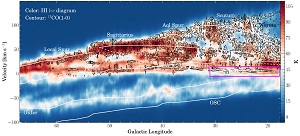 The Data Release 2 of The HI/OH/recombination line survey of the Milky Way (THOR) provides the most detailed view so far of the first Galactic quadrant at a 21 cm wavelength. The authors have combined observations from the Karl G. Jansky Very Large Array (VLA) and Green Bank Telescope (GBT) to recover the large-scale structure of the HI emission and achieve an angular resolution of 40". Among their results, the authors derive an opacity-correction factor that implies a total atomic gas mass of 9.4–10.5x10^9 M_sun when applied to the entire Milky Way.
The Data Release 2 of The HI/OH/recombination line survey of the Milky Way (THOR) provides the most detailed view so far of the first Galactic quadrant at a 21 cm wavelength. The authors have combined observations from the Karl G. Jansky Very Large Array (VLA) and Green Bank Telescope (GBT) to recover the large-scale structure of the HI emission and achieve an angular resolution of 40". Among their results, the authors derive an opacity-correction factor that implies a total atomic gas mass of 9.4–10.5x10^9 M_sun when applied to the entire Milky Way.
Modeling spectral lags in active galactic nucleus flares in the context of Lorentz invariance violation searches (Perennes et al.)
- Details
- Published on 23 January 2020
Vol. 633
In section 4. Extragalactic astronomy
Modeling spectral lags in active galactic nucleus flares in the context of Lorentz invariance violation searches
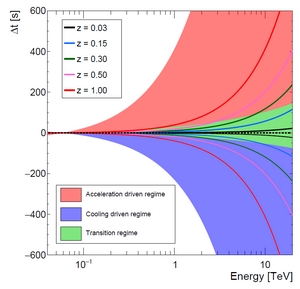
The paper indicates that intrinsic time delays, produced by acceleration and radiation mechanisms during blazar flares, can compromise searches for Lorentz invariance (LIV) violations at TeV energies. The authors simulated time dependent one-zone models, including inverse Compton and synchrotron losses. They concentrate on two acceleration regimes, long persistent and fast particle acceleration, and note that such spectral observations with the Cherenkov Telescope Array (CTA) will provide the new insights needed for active galactic nuclei (AGN) flare modeling, which will improve our ability to disentangle such systematics from LIV searches in the photon sector.
Planet formation around M dwarfs via disc instability (Mercer & Stamatellos)
- Details
- Published on 21 January 2020
Vol. 633
Sect. 10. Planets and planetary systems
Planet formation around M dwarfs via disc instability. Fragmentation conditions and protoplanet properties

Around 30 percent of the observed exoplanets that orbit M dwarf stars are gas giants, which are more massive than Jupiter. The origin of these planets is uncertain since M dwarf disks are not massive enough for core accretion, that is, the coagulation of dust particles to progressively larger aggregates and eventually planets, to operate. In this paper the authors examine the possibility that such planets form by the alternative theory of disk instability. They performed an ensemble of hydrodynamic simulations of M dwarf disks in order to determine the minimum disk mass needed for gravitational fragmentation to occur. They find that a relatively high disk-to-star mass ratio is required of at least 0.3. The resolution of the simulations presented is high enough to determine the initial properties of the planets formed by disk instability. The planets form quickly (within a few thousand years) at distances around 50 AU from the host star, and they are initially very hot; their centers have temperatures up to 12,000 K. The authors argue that future observations of massive M dwarf disks or planets in very young M dwarf systems will establish the importance of disk instability for planet formation around low-mass stars.
Peering into the formation history of beta Pictoris b with VLTI/GRAVITY long-baseline interferometry (GRAVITY Collab.)
- Details
- Published on 20 January 2020
Vol. 633
Sect. 10. Planets and planetary systems
Peering into the formation history of beta Pictoris b with VLTI/GRAVITY long-baseline interferometry
The 4th-magnitude beta Pictoris hosts an emblematic young planetary system that includes both one of the first debris disks, detected 30 years ago, and one of the first directly detected giant exoplanets a decade ago. Nowak et al. use the GRAVITY instrument on the VLT Interferometer to obtain both a high-quality R=500 K-band spectrum of the Beta Pic b planet and its position relative to the star with 50 microarcsecond accuracy. Together with archival astrometry, the new star-planet position indicates that their orbit is mildly eccentric and it improves previous mass measurements of the planet to 12.7 +- 2.2 Mjup mass. The authors also analyze the spectrum to derive a subsolar C/O abundance ratio in the planetary atmosphere, which points towards a formation of the planet through core accretion somewhere between the CO2 and H2O ice lines. Coupled with previous observations of the HR 8799 system, these observations demonstrate the great potential of spectrally resolved long baseline interferometry to characterize young planets and their formation mechanisms.
Formation of moon systems around giant planets (Ronnet & Johansen)
- Details
- Published on 17 January 2020
Vol. 633
Sect. 10. Planets and planetary systems
Formation of moon systems around giant planets Capture and ablation of planetesimals as foundation for a pebble accretion scenario
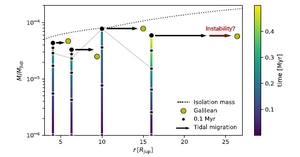
The formation of massive moons around giant planets, such as Jupiter and Saturn, is believed to take place in gaseous circum-planetary disks (CPDs), in a manner analogous to the formation of planets around stars. As a matter of fact, the jovian moons share many similarities with compact super-Earth and terrestrial-mass planet systems around solar-type stars and M-dwarfs. Yet, it remains unclear how the solid material needed to build the moons is brought to the CPDs of giant planets, as well as how the moons subsequently form and evolve out of this material. In this study, the authors show that planetesimals initially orbiting in the vicinity of a giant planet can be gravitationally captured when they interact with the gaseous CPD and experience, in most cases, sufficient frictional heating to be efficiently ablated, thereby feeding the planet’s disk with small dust grains. The authors demonstrate that the moons then mainly grow by accreting the pebbles that coagulate from the dust released via the ablation of planetesimals, and they rapidly migrate inward due to their tidal interaction with the gaseous CPD, resulting in their pile-up in resonant chains at the inner edge of the disk. Dynamical instabilities in these resonant chains could be at the origin of the different architectures of Jupiter’s and Saturn’s moon systems. This scenario is a direct analogy of the one proposed for the formation of super-Earths.
The GALEX Ultraviolet Virgo Cluster Survey (GUViCS) (Longobardi et al.)
- Details
- Published on 15 January 2020
Vol. 633
1. Letters
The GALEX Ultraviolet Virgo Cluster Survey (GUViCS) VIII. Diffuse dust in the Virgo intra-cluster space
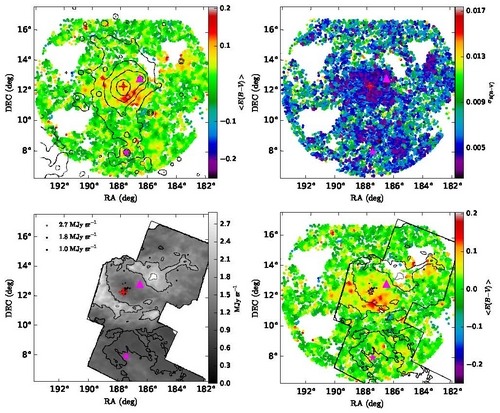 Dust is thought to be destroyed by sputtering in galaxy clusters, which are rich in X-ray emitting hot gas. However, some dust may still exist in shielded regions or from gas tails that have just been stripped from galaxies. Measurements of the amount of dust in clusters have derived extinctions between AV=0.004 and 0.5. The present work represents the first detection of diffuse dust in the intra-cluster medium of the Virgo cluster out to ~0.4 virial radius. The authors have used the near-ultraviolet-I colors of about 12000 background galaxies with redshifts 0.02 < z < 0.8, and find an average reddening E(B - V) ~ 0.042 mag within 1.5 degrees or 0.3 virial radius from the cluster’s center. Assuming a Large Magellanic Cloud extinction law, they derived an average visual extinction AV = 0.14, leading to a total dust mass of Md = 2.5 10^9Mo and hence a dust-to-gas mass ratio of Md/Mg = 3.0 x 10^-4, which is much lower than in the Milky Way. The far-infrared emission of the dust was not detected by Herschel at 250 micron; this means that either the dust temperature should be low, about 10 K, or that the dust has lower emissivity than usual. Nevertheless, this diffuse dust in the Virgo cluster must originate from the galaxies through tidal or ram-pressure stripping.
Dust is thought to be destroyed by sputtering in galaxy clusters, which are rich in X-ray emitting hot gas. However, some dust may still exist in shielded regions or from gas tails that have just been stripped from galaxies. Measurements of the amount of dust in clusters have derived extinctions between AV=0.004 and 0.5. The present work represents the first detection of diffuse dust in the intra-cluster medium of the Virgo cluster out to ~0.4 virial radius. The authors have used the near-ultraviolet-I colors of about 12000 background galaxies with redshifts 0.02 < z < 0.8, and find an average reddening E(B - V) ~ 0.042 mag within 1.5 degrees or 0.3 virial radius from the cluster’s center. Assuming a Large Magellanic Cloud extinction law, they derived an average visual extinction AV = 0.14, leading to a total dust mass of Md = 2.5 10^9Mo and hence a dust-to-gas mass ratio of Md/Mg = 3.0 x 10^-4, which is much lower than in the Milky Way. The far-infrared emission of the dust was not detected by Herschel at 250 micron; this means that either the dust temperature should be low, about 10 K, or that the dust has lower emissivity than usual. Nevertheless, this diffuse dust in the Virgo cluster must originate from the galaxies through tidal or ram-pressure stripping.
Magnetohydrodynamic simulations of a Uranus-at-equinox type rotating magnetosphere (Griton & Pantellini)
- Details
- Published on 15 January 2020
Vol. 633
Sect. 10. Planets and planetary systems
Magnetohydrodynamic simulations of a Uranus-at-equinox type rotating magnetosphere

Any solar system example provides a good departure point for understanding the physical processes and environments in the vastly diverse realm of exoplanetary systems. This is especially true for magnetospheres and interplanetary interactions with planetary magnetic fields. The Solar System example of Uranus is a remarkable oblique rotator whose magnetosphere shows long-time presentations of equatorial and polar-cusp to incoming supersonic flow. The authors study magnetohydrodynamic (MHD) simulations of an orthogonally-oriented planetary magnetosphere with incident unmagnetized and magnetized stellar wind flows. The magnetized wind induces reconnection and disconnection events as well as field distortions, some of which are more extreme than modeled for aligned fields. The neutral case shows field line distortions that produce puffs and tailward expulsions, especially in the rapidly rotting planetary model. While schematic at present, this paper demonstrates the tremendous promise of more physically realistic and computationally refined simulations to make significant observational predictions (e.g., auroral activity, nonthermal emission, and limits to atmospheric escape).
A gravitational lensing detection of filamentary structures connecting luminous red galaxies (Xia et al.)
- Details
- Published on 15 January 2020
Vol. 633
Sect. 3. Cosmology
A gravitational lensing detection of filamentary structures connecting luminous red galaxies
In this cosmic web, large under-dense regions (voids) are enclosed by anisotropically collapsed surface structures (sheets) and line structures (filaments) which intersect at the most overdense isotropic regions (clusters). Simulations predict that as much as 40% of the mass in the Universe should be located in filaments, however, its detection poses a great challenge. Filaments have been detected by Xray emission and, recently, by the SZ signal. In this paper, the authors investigate the use of weak gravitational lensing to detect their presence combining three large public weak lensing surveys: KIDS+VIKING, RCSLenS, and the CFHTLenS to improve upon previous methodologies with the help of N-body simulations. As a result, they find a 3.4 σ detection of filamentary structure connecting luminous red galaxies separated by 3 − 5 h−1 Mpc, while they do not detect significant signals for larger separations, which is contrary to previous claims. The average density at the centre of these filamentary structures is found to be 15 ± 4 times the critical density.
NGC 6240: A triple nucleus system in the advanced or final state of merging (Kollatschny et al.)
- Details
- Published on 14 January 2020
Vol. 633
Sect. 4. Extragalactic astronomy
NGC 6240: A triple nucleus system in the advanced or final state of merging
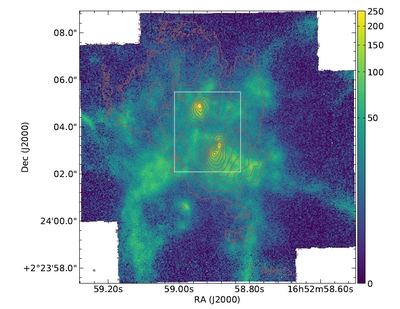
NGC6240 is a well known, nearby pair of merging galaxies. Optical, X-ray, and radio observations have shown that each galaxy of the pair hosts an active nucleus. MUSE on the VLT in the narrow-field mode with adaptive optics has allowed the authors to carry out a detailed optical 3D spectroscopic study with the very high spatial resolution of 75 mas (35 pc). The emission and absorption spectra, along with their dispersion, led the authors to claim that NGC6240 is, in fact, a system of three nuclei in the final state of merging. The southern component is indeed composed of two nuclei that are only separated by 198 pc. In combination with Gaia data, they reach an absolute positional accuracy of only 30 mas, which is essential to compare optical spectra with MERLIN/VLBA radio positions. In the NGC6240 system of three nuclei, two of them are active and all of them have a black hole mass in excess of 9 x 10^7Mo. This provides some insight into hierarchical galaxy formation via merging processes: It is known that multiple mergers lead to a faster evolution of massive galaxies in comparison to binary mergers. Triple massive black hole systems may accelerate the coalescence of a massive black hole, leading to the loudest sources of gravitational waves in the mHz regime.
First direct observation of a torsional Alfvén oscillation at coronal heights (P. Kohutova et al.)
- Details
- Published on 13 January 2020
Vol. 633
Sect. 1. Letters
First direct observation of a torsional Alfvén oscillation at coronal heights
The magnetized solar atmosphere can support a variety of waves. Torsional, or Alfvén waves, are promising candidates for transporting energy across different layers of the solar atmosphere and have been theoretically predicted for decades. Previous detections of Alfvén waves have, however, so far relied mostly on indirect signatures. Using data from the space-based IRIS observatory, the authors analyzed imaging and spectral observation of a surge of cool solar plasma which is triggered by a magnetic reconnection between open and closed magnetic field lines happening in the solar corona. The IRIS spectral data shows an oscillation in the line-of-sight velocity with a 180° phase difference at opposite edges of the surge flux tube. This signature of torsional oscillation is further complimented with an alternating tilt observable in the Si IV and Mg II k spectra across the flux tube and the trajectories traced by the individual threads of the surge material. Together these provide the first direct observational evidence that magnetic reconnection leads to the generation of large-scale torsional Alfvén waves in the solar corona.
A stripped helium star in the potential black hole binary LB-1 (A. Irrgang et al.)
- Details
- Published on 10 January 2020
Vol. 633
In section 1. Letters to the Editor
A stripped helium star in the potential black hole binary LB-1
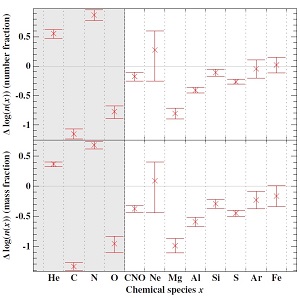
Very recently, the single-lined spectroscopic binary system LB-1 at a distance of 2.3kpc (inferred from the Gaia DR2 parallax) was claimed to contain a black hole of about 70 solar masses. This result is surprising, and would be completely at odds with current stellar evolution models as these do not predict such massive black holes in an environment that is as metal-rich as the Galactic solar neighborhood. In this Letter, the authors present a quantitative spectroscopic analysis of the visible component in LB-1 which reveals that this object is not an ordinary main sequence B-type star as previously assumed. Instead, the derived abundance pattern shows heavy imprints of hydrogen burning via the CNO bi-cycle, indicating that it is actually a stripped helium star. This result overturns the previous interpretation: the revised nature of the visible component significantly lowers the mass estimate to for the unseen companion, allowing values as low as 2-3 Msun; this is no longer in contradiction with stellar evolution models. The exact nature of the companion remains ambiguous for the time-being: it could be an ordinary black hole, a (massive) neutron star, or even a relatively unevolved main sequence star.
A thin shell of ionized gas as the explanation for infrared excess among classical Cepheids (V. Hocdé et al.)
- Details
- Published on 10 January 2020
Vol. 633
6. Interstellar and circumstellar matter
A thin shell of ionized gas as the explanation for infrared excess among classical Cepheids
Cepheids have played a crucial role in the distance scale and determination of the present value of the Hubble constant H_0. This distance ladder is, however, mainly based on the period-luminosity relation and uncertainties around this relation are one of the largest contributors to the error of H_0. The IR excess of classical Cepheids is poorly understood but it is likely to affect the PL relation in a systematic way. The authors built a phase-independent spectral energy distribution (SED) of a sample of Cepheids from visible to mid-IR wavelengths, compared the SED to atmospheric models, and derived the IR excess features. Furthermore, they showed that the excess cannot be explained by a hot or cold dust model of the circumstellar environment. A free-free emission from a thin shell of ionized gas around Cepheids can reproduce the observed IR excess. Further investigation is needed to understand the impact of the presence of an ionized gas shell on the PL relation
Explaining the low luminosity of Uranus: a self-consistent thermal and structural evolution (A. Vazan et al.)
- Details
- Published on 08 January 2020
Vol. 633
10. Planets and planetary systems
Explaining the low luminosity of Uranus: a self-consistent thermal and structural evolution

Unlike Jupiter, Saturn, and Neptune, which emit 1.7-2.6 times more energy than they receive from the Sun, Uranus has very low-to-zero intrinsic flux. This long-recognised feature has not been given any satisfactory explanation thus far. The low luminosity of Uranus indicates that its interior is non-adiabatic; either its internal energy has been lost or it remains captured in this interior. The former scenario is unsatisfying as it seems hard to understand why Uranus' interior would already be cold while the other outer planets remain in a cooling phase. Vazan and Helled explore the second possibility and, specifically, that a compositional gradient acts as a thermal boundary, isolating the inner hot region from the outer atmosphere, suppressing convection, and slowing down the cooling. They show that different types of composition gradients are stable over the planet's evolution time and can explain Uranus' observed radius, moment of inertia, and luminosity — without the need for artificial thermal boundaries. They also find that the initial energy content of Uranus was at most 20% of its accretion energy nd that convective mixing is limited in Uranus' outermost region. In contrast to Jupiter and Saturn, the atmosphere of Uranus today may not be very different from that of its primordial state.
Effect of wind-driven accretion on planetary migration (Kimmig et al.)
- Details
- Published on 16 December 2019
Vol. 633
10. Planets and planetary systems
Effect of wind-driven accretion on planetary migration
 The authors compare the efficiency of the wind-driven accretion process with respect to the viscous accretion process in protoplanetary disks. They show that for the co-orbital region, this wind-driven process always injects mass from the outer edge of the co-orbital region and removes mass from the inner edge, while the viscous process does not. As a consequence, wind-driven accretion may strongly alter our formation scenarios.
The authors compare the efficiency of the wind-driven accretion process with respect to the viscous accretion process in protoplanetary disks. They show that for the co-orbital region, this wind-driven process always injects mass from the outer edge of the co-orbital region and removes mass from the inner edge, while the viscous process does not. As a consequence, wind-driven accretion may strongly alter our formation scenarios.


